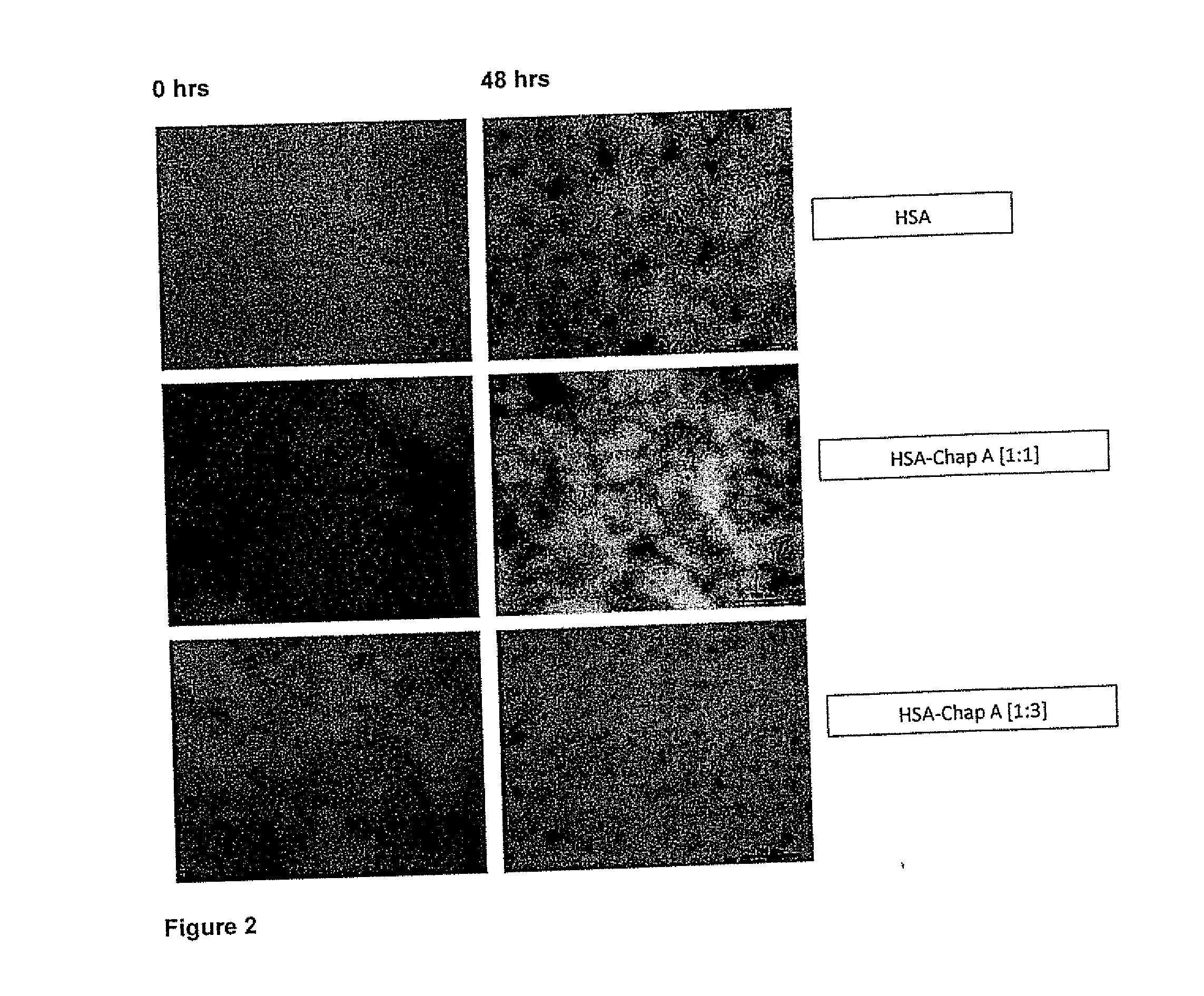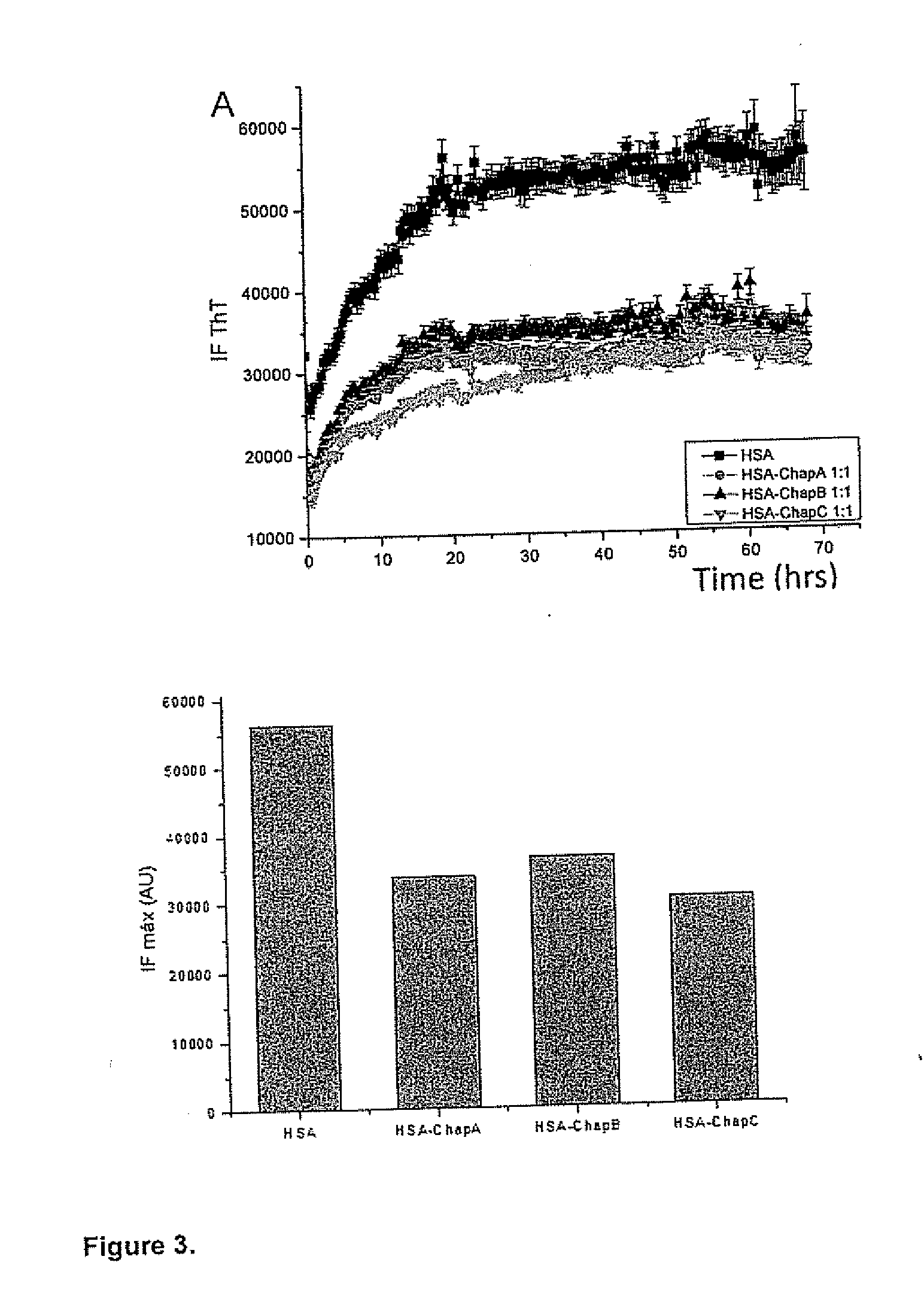Chemical chaperonins as novel molecular modulators of beta protein aggregation present in conformational diseases
- Summary
- Abstract
- Description
- Claims
- Application Information
AI Technical Summary
Benefits of technology
Problems solved by technology
Method used
Image
Examples
example 1
Evaluation of the Modulator Character of Chaperonins in HSA Fiber Formation by Transmission Electron Microscopy (TEM)
[0093]The preparation of the samples was performed at a final concentration of 3.017 μM of HSA in Tris buffer (pH=7.4, 20 mM) in the presence or not of the chaperonin A (3.017 μM y 9.051 μM). Incubate at 65° C. for 72 hours. Aliquots were taken every 2 h for TEM study.
[0094]HSA solution (5 μl) is placed in 300 mesh copper grids formvar covered for 3 minutes. The excess solution is removed with a micropipette. Subsequently uranyl (5 μL, 2%) is added previously centrifuged at 12,000 rpm for 10 minutes. Excess contrasting removed at 2 min. and the grids were air dried for a sufficient time. The observation and recording of the samples was performed using a microscope Jeol model JEM-1010 operated at 80 keV and coupled to a digital camera model MTI CCD-300-RC.
[0095]FIG. 2 shows that in the absence of chaperonins, abundant long and contoured HSA fibers are produced after 48...
example 2
Evaluation of Modulating Ability of Chaperonins in Fiber Formation of Human Serum Albumin (HSA)
Preparation of Study Solutions
[0096]Thioflavin-T(ThT): Th-T (Sigma, 47 mg) is dissolved in water until 25 mL as final volume.
[0097]HSA: HSA (300 μM) is prepared in buffer (glycine, pH=3, 50 mM, NaCl 100 mM) until 10 mL as final volume. The solution is filtered through a syringe filter with acrodisc type 0.20 microns pore (Supelco Analytical).
[0098]Chaperonin: chaperonin selected is dissolved in 25 mL of DMSO, as non-limiting example of the Formula I, (75.4 μmol; A, B, C, D,).
Experimental Procedure
[0099]250 μL of the HSA solution (300 μM) and the mixture of HSA with chaperonins (300 μM) was taken and placed in the respective wells (polystyrene plates, 96-well Costar 3615, Special Optics Plate) for adding ThT (1 μl) to each well to get a final concentration of 24 μM. Fluorescence signals are measured at λemis.=482 nm (λexcit.=450 nm) in a fluorescence spectrophotometer Infinite M1000, TECAN,...
example 3
Evaluation of Modulator Character of Chaperonins in the Kinetics of Fiber Formation of Bovine Serum Albumin (BSA) by Fluorescence Spectroscopy
Preparation of Study Solutions
[0101]Thioflavin-T (ThT): Th-T (Sigma, 10 mg) is dissolved in water and make to a final volume of 5 mL.
[0102]BSA: BSA (fraction V, MM: 66 296 Da, 500 mg) was dissolved and make to a final volume of 10 mL with buffer (glycine, pH=3; 50 mM; 100 mM NaCl). The dissolution is filtered through a filter syringe of the acrodisk type with pore 0.45 μm (Sigma-Aldrich). The exact concentration of the BSA, is calculated by considering the reported value of the molar extinction coefficient (ξ=43 824 AU·cm+1·M−1).
[0103]Chaperonin: Selected chaperonin, is dissolved as not limited example of Formula I, (75.4 μmol to A, B, C, D, E, F and G, FIG. 1) in 1.2 mL of DMSO and dilute to a final volume of 10 mL with buffer.
Experimental Procedure
[0104]250 μL from the BSA solution are taken (100 μM) and BSA with chaperonins mixtures (1 μM) ...
PUM
| Property | Measurement | Unit |
|---|---|---|
| Solubility (mass) | aaaaa | aaaaa |
| Molecular weight | aaaaa | aaaaa |
| Cytotoxicity | aaaaa | aaaaa |
Abstract
Description
Claims
Application Information
 Login to View More
Login to View More - R&D
- Intellectual Property
- Life Sciences
- Materials
- Tech Scout
- Unparalleled Data Quality
- Higher Quality Content
- 60% Fewer Hallucinations
Browse by: Latest US Patents, China's latest patents, Technical Efficacy Thesaurus, Application Domain, Technology Topic, Popular Technical Reports.
© 2025 PatSnap. All rights reserved.Legal|Privacy policy|Modern Slavery Act Transparency Statement|Sitemap|About US| Contact US: help@patsnap.com



